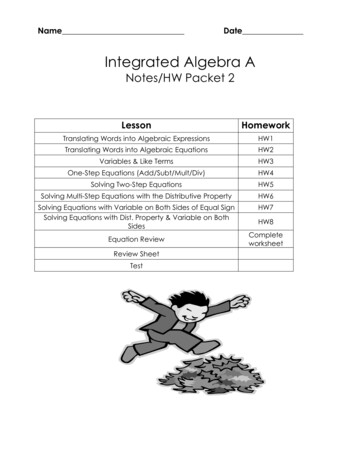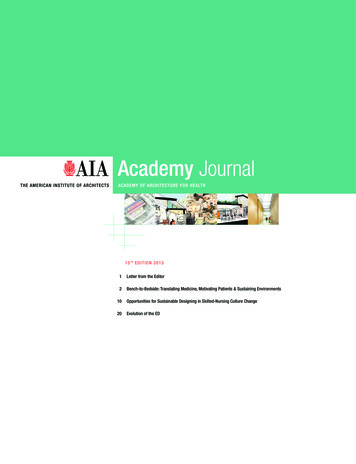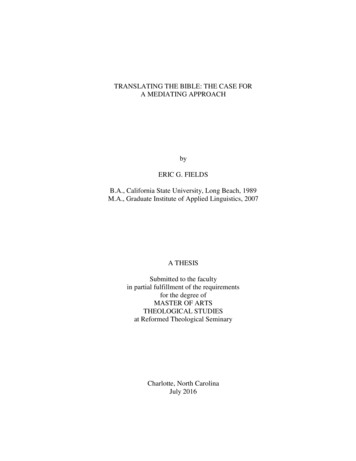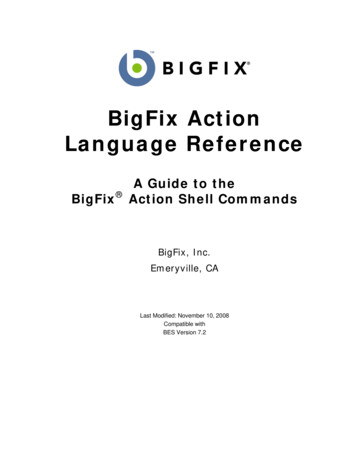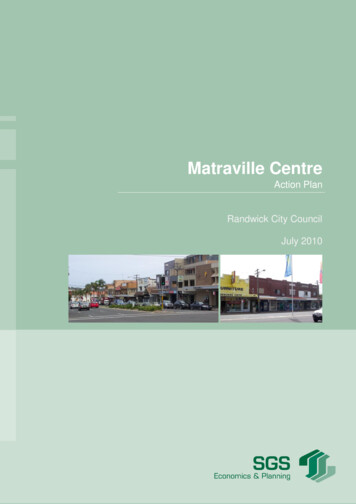
Transcription
Translating Information into Action:A Public Health Experiment in BangladeshReshmaan HussamAbu ShonchoyChikako YamauchiKailash PandeyDepartment of EconomicsFlorida International UniversityWorking Paper 2127December 202111200 SW 8th Street, Miami, Florida 33199https://economics.fiu.edu/
TRANSLATING INFORMATION INTO ACTION:A PUBLIC HEALTH EXPERIMENT IN BANGLADESHReshmaan Hussam †, Abu Shonchoy‡,Chikako Yamauchi§, and Kailash Pandey¶December 22, 2021AbstractWhile models of technology adoption posit learning as the basis of behavior change, information campaigns in public health frequently fail to change behavior. We design aninformation campaign embedding hand-hygiene edutainment within popular dramas usingmobile phones, randomly distributed to households in Bangladesh. We document no changein hygiene knowledge, yet substantial improvements in handwashing and health. Employingmachine learning techniques with temporal data on media exposure and handwashing, wefind that a combination of cumulative and immediate exposure predicts washing, consistentwith cue-based habituation. Results highlight how behavior change may be induced by tacit,rather than explicit, knowledge acquisition. We are indebted to research assistant Mohammed Helal Uddin and Nayamat Tasnim Ullah, as well asthe survey firm MOMODa in Gaibandha, Bangladesh. This work was supported by Japan Society for thePromotion of Science (JSPS) KAKENHI Grant Number 25101002. This study is registered in the AEA RCTRegistry and the digital object identifier (DOI) is: “10.1257/rct.8074-1.0.” IRB approval for endline datacollection at IRB18-1380.†Harvard Business School; corresponding author: rhussam@hbs.edu. (617) 495-6378. Address: MorganHall, 15 Harvard Way, Boston, MA 02163.‡Department of Economics, Florida International University, shonchoy@fiu.edu§GRIPS, c-yamauchi@grips.edu¶Harvard Business School; kpandey@hbs.edu1
1IntroductionModels of technology adoption frame behavior change as precipitated by information acquisition: agents possess some knowledge, or priors, over the returns to a behavior, receivenew information via information provision or experimentation, update their priors, and engage if returns outweigh costs (Arrow (1962); Janvry, Macours, and Sadoulet (2017); Fosterand Rosenzweig (1995); Conley and Udry (2010)). A shift in knowledge is a prerequisiteto behavior change. It is this theory of change that motivates the profusion of informationcampaigns in public health.Against this backdrop, we administer an information campaign that fails to alter explicitknowledge, yet meaningfully improves behavior and health. How does such change transpire?Our high-frequency temporal data on informational inputs and behavioral outcomes pointsto the role of salience and tacit knowledge, or know-how via accumulated exposure and experience that cannot be measured directly (Hadjimichael and Tsoukas, 2019), in transforminginformational content into action.We explore this process in the context of handwashing with soap in Bangladesh. Tofocus on the translation of information into action, we choose a setting in which neither theraw materials required for the act nor the social norms surrounding it are a constraint: 100%of our households own soap and 99% rinse their hands with water before eating. Familiespossess some, but not complete, knowledge of proper hygiene behavior: 83% of mothersbelieve soap removes germs from hands, but 64% do not think that soap will make handsclean if they already appear clean. 54% of mothers volunteer handwashing as a methodof preventing diarrhea, but only 1% believe handwashing can prevent colds. We thereforeoperate in a space where an information campaign may alter behavior either by shiftingthe priors about returns that individuals may hold, or through the ‘translation function’ ofpriors into action.Such behavior change is critical to child health across the developing world. Diarrhealand respiratory illnesses from unsafe sanitation and hygiene practices kill nearly one millionpeople each year and stunt the growth of millions more (WWAP, 2019). Relative to expensiveinfrastructural investments, improvements in individual hygiene involve small changes withpotentially substantial returns: handwashing with soap, for example, can drastically reducediarrhea and respiratory infection by interrupting the transmission of pathogens into thebody (Freeman et al., 2014; McGuinness et al., 2018). While successful in intensive andcostly programs, practitioners face the challenge of identifying low cost, scalable interventionsthat yield sustained improvements in behavior and health.1 This study proposes one such1While there exist a wide array of studies in the space of sanitation and hygiene in the developing world,2
program.We design a scalable edutainment campaign using existing public service announcementson hand hygiene. The intervention is motivated by the documented successes of other edutainment in shifting behavior around fertility (Ferrara, Chong, and Duryea, 2012), migration(Farré and Fasani, 2013), and energy (Jacobsen, 2011), among others. Our medium is themobile phone, whose penetration in rural Bangladesh has grown rapidly (GSMA, 2014),a trend mirrored across much of the developing world. Network reliability and internetaccessibility remain poor, so households forgo streaming and rely on SD cards preloadedwith content (see Figure A1) for their entertainment needs.2 Our intervention embeds edutainment within popular dramas and movies and distributes call-disabled smartphones withpreloaded SD cards to randomly selected households in rural Bangladesh. We provide anequal platform for all treated households to view content by issuing them a simple smartphone (valued at 50 USD). We disable network capabilities to focus the intervention on thepreloaded edutainment.To measure changes in hand hygiene due to the intervention, we distribute handsoapdispensers embedded with time-stamped sensors to all households. This technological innovation addresses the serious challenges posed by standard participant observation measuresof hand hygiene, making data collection unobtrusive, objective, and precise (Hussam et al.,2021; Ram et al., 2010; Biran et al., 2008) (see Figures A2 and A3 for sensor diagram andinstallation).Our analysis proceeds in three steps. We first examine the relationship between edutainment consumption and behavior change. We find that daily handwashing rates, as measuredby the sensor technology, increase significantly due to the intervention: treated householdswash 20% (p 0.000) more than their control counterparts.Contrary to the purported intent of such a campaign however, this change in behavioris not driven, insofar as can be measured through detailed survey questions, by a shift inknowledge about the returns to handwashing. Nor is baseline knowledge correlated withthe size of the treatment effect. What, then, is the nature of information exposure thatmany suffer from methodological limitations (see a survey of the literature in Kremer and Peterson Zwane(2007)). Those that utilize methods such as randomized control trials employ intensive and costly interventions to improve both hygiene practices and health (e.g., Khan (1982); Haggerty et al. (1994); Luby et al.(2005)). Bennett, Naqvi, and Schmidt (2018) designs a particularly effective, but costly, learning-basedintervention: they find that individual examination of microbes under a microscope yields meaningful improvements in hand hygiene and health, relative to instruction alone. Efforts to identify scalable interventionsare mixed: some community- or school-based interventions, by utilizing local volunteers receiving modestcompensation for information dissemination, generate modest behavior and health impacts (Bowen et al.,2012; Huda et al., 2012; Biran et al., 2014), while similar community-based hygiene promotion interventionsdo not (Biran et al., 2009; Lewis et al., 2018).2Also seen in India (Tenhunen, 2018).3
leads to behavior change? We collect data on patterns of exposure and find that, controllingfor a rich set of household characteristics, households where children watched any phoneentertainment within the last reporting period are significantly more likely to wash, as arehouseholds in which the mother volunteers the children’s handwashing cartoon as one of herfavorite pieces of entertainment. The former suggests that recency of exposure matters (theentertainment may serve as a reminder, or trigger, to wash), while the latter suggests thatparental preferences are complements to child exposure in behavior change.To further probe the role of exposure recency in behavior change, we exploit minute-leveltime series data from an application within the mobile phones that tracks media consumption. Paired with our minute-level data on handsoap dispenser use, we assemble a uniquepanel dataset of behavioral inputs (media exposure) and outputs (handwashing behavior)and employ machine learning techniques to uncover which patterns of entertainment exposure best predict future handwashing behavior. The machine learning approach is suited tothis objective, as ex ante the literature offers no priors around what temporal patterns of exposure generate shifts in behavior. However, the application is nontrivial: existing machinelearning work with time series data (for example, stock price predictions, such as that inGu, Kelly, and Xiu (2019)) employ past features (eg. prices) to predict like future features.In such settings moreover, an interpretable weighting of features is unnecessary as long asthe model’s predictive capacity is high. In our setting, we employ one set of past features(exposure to campaign) to predict a separate future feature (handwashing), and recovery ofrelative weights is necessary to the underlying policy goal: how should edutainment campaigns be structured, in frequency and length of stimulation, to maximize behavior change?Improving upon existing work to address these challenges, we find that cumulative exposureto edutainment during the month prior to a washing episode is most predictive of soap use,followed by immediate exposure to entertainment 30 minutes prior to a washing episode. Allother temporal features, including exposure to content beyond one month or 31 to 60 minutes prior, have near zero predictive value. This is consistent with handwashing becominga cue-based habit, in which cumulative exposure to edutainment familiarizes one with thebehavior and associates it with phone exposure, and immediate exposure then serves as thenecessary trigger to wash.Because only treated households can produce data on watching patterns, we venture nocausal claims in these latter two exercises. However, the random placement of ads within alarger entertainment package reduces the role of choice in exposure, and the inclusion of dayand household-level fixed effects in the machine learning exercise ease concerns of paralleltime trends, reverse causality and selection on household-type. We uncover a sensible set ofpatterns around recent exposure, cumulative exposure, and familial complementarities that4
can inform the design of future mechanism experiments and the administration of publichealth information campaigns.Having documented impacts of the intervention on hand-hygiene behavior, we next estimate the effect of the edutainment package on the health of treated children. We findsubstantial reductions among children in treated households relative to their control counterparts on the incidence of loose stool ( 54%, p 0.011) and symptoms of acute respiratoryinfection (ARI) ( 29%, p 0.005). We find no effect of the campaign on other sanitationor hygiene behaviors, suggesting that the estimated health impacts are indeed driven bychanges in hand hygiene. These health improvements persist over the course of the twelvemonths of data collection despite an edutainment intervention which lasts only eight months.To benchmark our health results against the status quo (households with soap but noedutainment campaigns and no dispensers), we supplement our randomized sample with asample of households drawn from our initial census. While this “pure control” group is notrandomized, their only observable divergence from our experimental sample is that mobilephones were already employed as a primary source of entertainment in these homes, makingthem ineligible for our experimental sample. We collect child health data from this samplefor the final six months of the experiment. We find that, relative to this “pure control”sample, children who received the dispenser (but no edutainment treatment) exhibit 68%lower incidence of loose stool (p 0.015) and 52% lower incidence of symptoms of ARI (p 0.029). This suggests that the dispenser alone had substantial effects on hand hygienebehavior and subsequent health, echoing a finding of Hussam et al. (2021) in West Bengal.Reframing the results of the edutainment campaign in light of the effect of the dispenseralone, we interpret the dispenser as a potentially critical complement to edutainment: households require not only the material resources of soap and water (which all households in oursetting possess), but also a convenient and user-friendly medium of use, in order to act uponthe content delivered in a public health campaign.We view the contributions of this study as threefold. First, our results on exposurerecency build upon literature around the value of reminders, often delivered via text messages, for building healthy behaviors (e.g. Patrick et al. (2009); Koshy, Car, and Majeed(2008); Karlan et al. (2016).34 Beyond the binary presence or absence of a reminder, ourmobile phone and dispenser technology allow us to examine precise temporal relationships3Related is recent work by Bettinger et al. (2021), which finds that ‘content-less’ text message remindersare as effective as texts bearing informative content about a child’s inputs to education. The primary channelin this context, however, remains information: content-less messages encourage parents to secure the relevantinformation to encourage their childrens’ educational performance.4While the underlying mechanism of increasing salience may be the same, text message interventionsrequire the decision of timing to be made by the experimenter, precluding an exploration of which temporalpatterns of exposure are most predictive of behavior change.5
between inputs (edutainment exposure) and outputs (handwashing behavior). We identifythe features of edutainment exposure that are most predictive of handwashing, clarifyingthe windows of time during which exposure may be most impactful. This high-frequencytime-series data on both information stimuli and subsequent behavior has not been utilized,to our knowledge, in existing studies of behavior change or technology adoption, and offersa path forward to empirically constructing the translation function of information exposureinto action even in the absence of explicit changes in knowledge.Second, we document that prolonged information campaigns can generate meaningfulchanges in behavior despite no measurable change in knowledge. This suggests that designersof information campaigns may be well served to consider the tacit means by which theircampaigns can engender behavior change, rather than focusing on the dispensation of factsper se. While consumers may be unable to consciously recognize factual information aboutthe returns to a technology or behavior, the act of repeatedly conveying informative contentto a captive audience of families can serve to familiarize, and associate a cue, with thepromoted behavior (cumulative exposure), make the behavior salient by triggering the cue(immediate exposure), and facilitate complementary behavior change between parent andchild, resulting in increased adoption with no commensurate change in explicit knowledge.We denote this combination of effects under the umbrella of ‘tacit knowledge,’ distinct fromexplicit knowledge in a manner similar to Romer (2000)’s theoretical distinction between‘feeling’ and ‘thinking.’ Our findings are consistent with psychological and economic modelsof cue-based habit formation (Wood and Neal, 2007; Laibson, 2001) as well as recent work inneuroscience that identifies the brain’s ‘default mode network’ to serve the role of autopilot:through repeated exposure and contextual triggers, we engage in behavior with no consciousawareness of why or that we are doing so (Vatansever, Menon, and Stamatakis, 2017; Raichle,2015). Our results, however, also offer insight into why impacts of information campaignsmay be short-lived: in the absence of the intervention, cues to trigger behavior disappear.As underlying priors about the returns have not shifted, neither will subsequent behavior.Third, we devise a simple and scalable intervention that manages to not only shift hygiene behavior but also generate meaningful and sustained improvements in child health.The greater part of information campaigns in the hygiene and sanitation space have beenunable to produce health improvements (see, for example, Biran et al. (2009); Chase andDo (2012); Galiani et al. (2016); Null et al. (2018); Lewis et al. (2018); Bennett, Naqvi,and Schmidt (2018), with its innovative use of microscopes, is a notable exception in healthoutcomes and affordability), and the few that record changes in behavior without subsequenthealth effects employ self-reports or observational data (such as Tidwell et al. (2019), whichalso documents improvements in handwashing from a media campaign) with their concomi6
tant challenges (Ram et al., 2010; Biran et al., 2008). Health effects of the magnitudes wedocument are uncommon in the literature: a lower bound of 6.50 USD per household forthe cost of the SD card ( 2 USD), dispenser ( 3.50 USD), and ten months of soap ( 1 USD),and an upper bound of 65 USD for the cost of the SD card, dispenser, soap, card delivery,and phone - both estimates that are likely to drop as phone and internet penetration grow,and dispensers are produced domestically at scale, across the developing world.Beyond hand hygiene, a behavior of increasing importance in the wake of the globalCOVID-19 pandemic, this work may speak to the design and dissemination of public healthinformation campaigns for other low cost, high return, and repetitive behaviors, with particular relevance to behaviors such as water treatment and mask-wearing.The remainder of the paper proceeds as follows. Section 2 describes the design andimplementation of the experiment, Section 3 presents the analysis and results, and Section4 concludes.2Experimental DesignOur study was conducted in Gaibandha District, Bangladesh, among 333 households across34 villages. All households had at least one child of primary school age, access to a latrine,and a female head of household who did not own a mobile phone. All households receiveda handsoap dispenser with a sensor embedded inside. Randomization was executed viacomputer, with 50% of households allocated to treatment.Once per month, all households were visited, and their dispensers were refilled. Givenour limited supply of sensors, a randomly selected third of dispensers included sensors inany given month; in the subsequent month, these sensors were extracted, data downloaded,and sensors then inserted into the next third of households, and so on over the course ofeight months. As such, we have approximately two months of sensor data per household,but representative data of a balanced sample of control and treatment households.The intervention lasted from April 2017 to November 2017. During this period, enumerators collected sensor data as well as data on child health and [for treatment households] selfreported entertainment exposure during their monthly visits. Using an application preloadedonto the smartphones, enumerators also extracted data for treated households on mobilephone watching patterns. An endline survey was conducted in April 2018. Follow-up ratesvary by data type: the endline survey was completed for 86% of the sample, interim healthsurveys for 97% of the sample, the sensor data for 85% of the sample, and the mobile phonedata for 54% of the [treated] sample. Lower followup rates for sensor and mobile phonedata come not from household attrition but rather technical failures. Enumerators faced7
difficulties transferring data to laptops in the field, and many files were corrupted duringextraction.Table A1 demonstrates balance across treatment and control households at baselinealong a host of sociodemographic, hygiene behavior, and hygiene knowledge characteristics.Table A2 presents balance along these features for the subsample of households in each datasource. We see no evidence of differential attrition: baseline characteristics are balancedbetween treated and control households for whom we were able to secure followup data ineach source, and the subsample of households for whom we have mobile phone data arecomparable to the full sample of households.2.1Edutainment campaignThe edutainment campaign was delivered via a smartphone for which the phone technologyhad been disabled, leaving only a screen. The device was provided to treatment householdsafter the baseline with an SD card preloaded with three hours of dramas and cartoons.Between each preloaded [non-informative] drama or cartoon, we embedded an ad campaign around proper hand hygiene. These ads ranged from thirty seconds to seven minutesand were drawn from a set of publicly available material (for example, see links to the following: Meena Cartoon, Bangladesh campaign, and Sesame Street). Enumerators deliveredSD cards with new dramas and cartoons to all treatment households monthly.3Analysis and ResultsWe present the results in three stages. First, we examine whether the intervention reachedits intended audience. We then estimate its impact on hand hygiene behavior and explorethe underlying mechanisms. Third, we consider whether these behavioral changes wereconsequential in terms of child health.3.1Impact of edutainment campaign on media consumptionTo document that our intervention reached its intended audience, we run the followingregression:M ediah α βT reatedh Mh0 h(1)Where M ediah represents a series of outcomes around media engagement for householdh drawn from the endline data, namely: whether the phone is used for entertainment by the8
mother, how many minutes per day is spent watching entertainment on the phone, whetherthe child edutainment content (‘cartoons’) are watched on the phone, whether the childrenuse the phone as entertainment, how many minutes per day the child watches, whether thechild watches daily, what time of day the phone is engaged with, and whether the childwatches cartoons on the phone. Mh0 represents the baseline value of the outcome.Results are presented in Table 1. Treated mothers report using a mobile device forentertainment 73 pp (340%, Column 1) more than control households. Treated children are38 pp (132%, Column 4) more likely to employ their phone as a source of entertainment thancontrol children, and more than three times more likely to watch the device daily (Column6). All other measures exhibit similar magnitude effects, are significant at the one percentlevel, and are robust to the inclusion of a rich set of sociodemographic controls (not shown).3.2Impact of edutainment campaign on handwashing behaviorWe now examine whether edutainment exposure resulted in behavior change, as documentedfrom the dispenser sensor data. To do so, we run the following regression:Handwashinght α βT reatedht γt δv ht(2)Where Handwashinght represents daily dispenser use as measured either in binary form(one if the dispenser was pressed at all in the day and zero otherwise) or continuously (thetotal number of presses that day), γt is day level fixed effects, and δv is village level fixedeffects. Standard errors are clustered at the household level.Results are presented in Table 2. Treated households use the soap dispenser 20% more ona given day than their control counterparts. Figure A4 depicts the evolution of handwashingbehavior over the course of the eight months during which we collected sensor data. Bothtreated and control households exhibit enthusiasm with the dispenser in the initial weeks,with treated households particularly engaged, and engagement declining over time.Is this behavioral change consequential? Section 3.3 explores whether this increase inhand soap use yields health improvements. The short answer is yes: this impact, thoughtemporary, has significant and lasting consequences for child health. Columns 5 and 6 ofTable 2 suggest why: treated households are not only more likely to wash more per day, butare also 3.4 percentage points, or 19%, more likely to wash during dinnertime, a critical timeof day in which exposure to germs can directly affect health through food consumption.We spend the remainder of this section exploring the mechanisms of information internalization: what dimensions of exposure to the edutainment campaign generated the behavioral- and consequently health - improvements we observe?9
We first estimate whether the edutainment program shifted the knowledge of treatedhouseholds, ostensibly the central channel through which the intervention should alter behavior. We asked respondents a series of questions regarding their knowledge of hand hygiene:if and why soap is useful, how it differs from washing only with water, whether colds arecontagious, and what actions can prevent colds and diarrhea.Results are presented in Table 3. Across all measures, controlling for baseline knowledge,we see no discernible improvement among treated households; results remain unchangedwith the inclusion of sociodemographic controls (not shown). Columns 8 and 9 examine theimpact of the intervention on handwashing behavior separately for those above and below themedian baseline score on the hygiene knowledge index: households who have more to learnaccording to self-reported knowledge of handwashing returns do not exhibit larger treatmenteffects than their more knowledgeable counterparts. This set of results suggests that (1) thecontent delivered through the information campaigns shifted knowledge in tacit, rather thanexplicit, ways, and/or (2) the campaign was effective not as an educational tool but ratheras a visual reminder to engage in a behavior.3.2.1Temporal dynamics of information acquisition and behavior changeTo probe these alternative channels, we employ a rich set of data collected over the courseof the experiment on how households engaged with the edutainment campaign. We firstexamine our time-series data on media consumption and handwashing to consider how thetemporality of information exposure translates to behavior change. Does exposure overthe course of weeks matter? Does immediate exposure matter while earlier exposure isforgotten? Our high-frequency data on the input of edutainment exposure and the outputof handwashing, paired with machine learning techniques, presents a unique opportunity toshed light on the temporal nature of information-driven behavior change.Given that we only observe media exposure data for treated households, and watchingthe media is a potentially endogenous choice, this exercise is by nature exploratory. However,three features of the setting and the analysis reduce the primary channels of endogeneity:edutainment videos are interspersed unexpectedly within the entertainment, and all modelsinclude fixed effects for households - reducing concerns of selection into washing - and days- reducing concerns of parallel time trends or reverse causality from washing to watching.Our dataset for this exercise is composed of the handwashing outcome, which takes theform of a binary variable in which a one indicates that the dispenser was pressed at leastonce during the breakfast (dinner)-time range on a given day and zero otherwise, and aseries of temporal feature variables around exposure to the hygiene information campaign:10
namely, binary and continuous measures of exposure to edutainment and entertainment inthe previous thirty minutes, hour, week, twelve weeks, and interims periods. All observationsare collapsed to the household-day-mealtime level. Details on all temporal features and dataconstruction decisions are described in Appendix A.2 (Chawla et al. (2002), Norberg (2016),Bergstra and Bengio (2012)).A comparison of the predictive performance in training and test sets across the lasso,elastic net, and random forest algorithms is presented in Table A4. The elastic net exhibitsthe highest testing accuracy at 62%. We then employ this algorithm to rate features by‘importance,’ a means of classifying the contribution of each variable to the model which,in the case of the elastic net, is the absolute value of the coefficient for each variable inthe tuned model (Kuhn, 2020). Figure A5 presents the top four features selected by theelastic net algorithm. The algorithm identifies the total number of minutes of exposure tothe edutainment campaign over the previous three and four weeks as most important (withimportance of 0.12 and 0.09 respectively), followed by whether the entertainment portionswere watched in the past half hour (importance of 0.06). All other features, including binaryor cumulative exposure of edutainment or entertainment at, for example, five or more weeks,two weeks, and two hours, exhibit importance scores of 0.001 or below.These selected temporal features suggest that both long term, cumulative exposure andimmediate exposure to the programs determine whether a household will wash in a givenmealtime. Interestingly, while the long term features [of three to four weeks prior] rely onexposure to the edutainment campaign, the immediate feature [of half an hour prior] relieson exposure to the non-informative enter
Florida International University Working Paper 2127 December 2021 11200 SW 8th Street, Miami, Florida 33199 https://economics.fiu.edu/ Translating Information into Action: A Public Health Experiment in Bangladesh Reshmaan Hussam Abu Shonchoy Chikako Yamauchi Kailash Pandey
